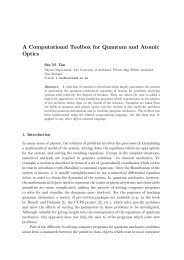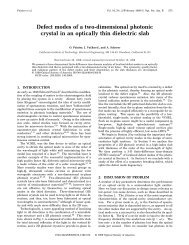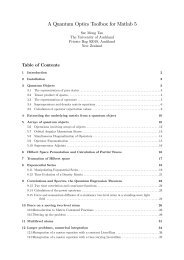Slowing and stopping light using an optomechanical crystal array
Slowing and stopping light using an optomechanical crystal array
Slowing and stopping light using an optomechanical crystal array
You also want an ePaper? Increase the reach of your titles
YUMPU automatically turns print PDFs into web optimized ePapers that Google loves.
6<br />
where k 0 = ω 1 /c. We solve the above equations to find the reflection <strong><strong>an</strong>d</strong> tr<strong>an</strong>smission<br />
coefficients r, t of a single element for a right-propagating incoming field of frequency ω k (see<br />
the appendix). In the limit where γ m = 0, <strong><strong>an</strong>d</strong> defining δ k ≡ ω k − ω 1 ,<br />
δ k κ ex<br />
r(δ k ) = −<br />
, (6)<br />
δ k (−2iδ k + κ) + 2i 2 m<br />
while t = 1 + r. Example reflect<strong>an</strong>ce <strong><strong>an</strong>d</strong> tr<strong>an</strong>smitt<strong>an</strong>ce curves are plotted in figure 1(c). For<br />
<strong>an</strong>y non-zero m , a single element is perfectly tr<strong>an</strong>smitting on reson<strong>an</strong>ce, whereas for m = 0<br />
reson<strong>an</strong>t tr<strong>an</strong>smission past the cavity is blocked. When m ≠ 0, excitation of the cavity mode is<br />
inhibited through destructive interference between the incoming field <strong><strong>an</strong>d</strong> the optomech<strong>an</strong>ical<br />
coupling. In EIT, a similar effect occurs via interference between two electronic tr<strong>an</strong>sitions. This<br />
<strong>an</strong>alogy is further elucidated by considering the level structure of our optomech<strong>an</strong>ical system<br />
(figure 1(d)), where the interference pathways <strong><strong>an</strong>d</strong> the ‘’-type tr<strong>an</strong>sition reminiscent of EIT<br />
are clearly visible. The interference is accomp<strong>an</strong>ied by a steep phase variation in the tr<strong>an</strong>smitted<br />
field around reson<strong>an</strong>ce, which c<strong>an</strong> result in a slow group velocity. These steep features <strong><strong>an</strong>d</strong><br />
their similarity to EIT in a single optomech<strong>an</strong>ical system have been theoretically [21, 22] <strong><strong>an</strong>d</strong><br />
experimentally studied [23, 24], while interference effects between a single cavity mode <strong><strong>an</strong>d</strong><br />
two mech<strong>an</strong>ical modes have also been observed [25].<br />
From r, t for a single element, the propagation characteristics through <strong>an</strong> infinite <strong>array</strong><br />
(figure 2(a)) c<strong>an</strong> be readily obtained via b<strong><strong>an</strong>d</strong> structure calculations [10]. To maximize the<br />
propagation b<strong><strong>an</strong>d</strong>width of the system, we choose the spacing d between elements such that<br />
k 0 d = (2n + 1)π/2 where n is a non-negative integer. With this choice of phasing, the reflections<br />
from multiple elements destructively interfere under optomech<strong>an</strong>ical driving. Typical b<strong><strong>an</strong>d</strong><br />
structures are illustrated in figures 2(b)–(f). The color coding of the dispersion curves (red for<br />
waveguide, green for optical cavity <strong><strong>an</strong>d</strong> blue for mech<strong>an</strong>ical reson<strong>an</strong>ce) indicates the distribution<br />
of energy or fractional occupation in the various degrees of freedom of the system in steady<br />
state. Far away from the cavity reson<strong>an</strong>ce, the dispersion relation is nearly linear <strong><strong>an</strong>d</strong> simply<br />
reflects the character of the input optical waveguide, while the propagation is strongly modified<br />
near reson<strong>an</strong>ce (ω = ω 1 = ω 2 + ω m ). In the absence of optomech<strong>an</strong>ical coupling ( m = 0), a<br />
tr<strong>an</strong>smission b<strong><strong>an</strong>d</strong> gap of width ∼κ forms around the optical cavity reson<strong>an</strong>ce (reflections from<br />
the bare optical cavity elements constructively interfere). In the presence of optomech<strong>an</strong>ical<br />
driving, the b<strong><strong>an</strong>d</strong> gap splits in two (blue shaded regions) <strong><strong>an</strong>d</strong> a new propagation b<strong><strong>an</strong>d</strong> centered<br />
on the cavity reson<strong>an</strong>ce appears in the middle of the b<strong><strong>an</strong>d</strong> gap. For weak driving ( m κ), the<br />
width of this b<strong><strong>an</strong>d</strong> is ∼4 2 m /κ, whereas for strong driving ( m κ), one recovers the ‘normal<br />
mode splitting’ of width ∼2 m [26]. This relatively flat polaritonic b<strong><strong>an</strong>d</strong> yields the slow-<strong>light</strong><br />
propagation of interest. Indeed, for small m , the steady-state energy in this b<strong><strong>an</strong>d</strong> is almost<br />
completely mech<strong>an</strong>ical in character, indicating the strong mixing <strong><strong>an</strong>d</strong> conversion of energy in<br />
the waveguide to mech<strong>an</strong>ical excitations along the <strong>array</strong>.<br />
It c<strong>an</strong> be shown that the Bloch wavevector near reson<strong>an</strong>ce is given by (see the appendix)<br />
k eff ≈ k 0 + κ exδ k<br />
+ iκ exκ in δk<br />
2<br />
2d 2 m<br />
4d 4 m<br />
+ (2κ3 ex − 3κ exκ 2 in + 12κ ex 2 m )δ3 k<br />
24d 6 m<br />
. (7)<br />
The group velocity on reson<strong>an</strong>ce, v g = (dk eff /dδ k ) −1 | δk =0 = 2d 2 m /κ ex, c<strong>an</strong> be dramatically<br />
slowed by <strong>an</strong> amount that is tunable through the optomech<strong>an</strong>ical coupling strength m . The<br />
quadratic <strong><strong>an</strong>d</strong> cubic terms in k eff characterize pulse absorption <strong><strong>an</strong>d</strong> group velocity dispersion,<br />
New Journal of Physics 13 (2011) 023003 (http://www.njp.org/)






